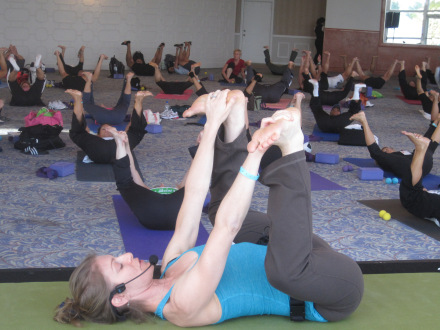
A few years ago, I thought tight hips were limiting me from certain movements, so I chose Vinyasa yoga to increase my flexibility. What I didn’t realize then was that most yoga classes require external rotation of the hip, such as Warrior 2, Triangle, Extended Side Angle, Pigeon, etc. The yoga practice I chose was overworking the muscles that externally rotated my hip and weakened my already underactive inner thigh muscles and hip adductors. This consistent overuse of external rotation was creating an imbalance in my body and I had no idea. I was overstretching my muscles, degenerating tissues, and causing instability in my body. Over time, when my hip flexibility started to increase, so did my yoga hip pain.
It was a dull pain on the right side of my hip that worked its way down the upper front portion of my leg. The sensation originated near the gluteus medius and traveled towards the Tensor fasciae latae, iliotibial band, sartorious and part of the rectus femoris. For a while I ignored it, still being aware of the sensation every time I performed a physical activity.
Instead of harnessing my critical thinking skills to identify the areas of my body that needed to be strengthened, lengthened, and mobilized, I stretched one area of my hip instead. It wasn’t until I began learning about Yoga Tune Up® and The Roll Model Method® several years ago that I learned how much harm I was doing by focusing on too much of one thing. I now understand that in order to “open up” the hips, we must move the ball and socket joint and its connective tissues in external and internal rotation, flexion, extension, circumduction, adduction, and abduction.
Here are the exercises for hip pain relief that helped me ease discomfort in my hip and regain the natural mobility of the joint, which in turn increased the flexibility I was looking for.
I perform Adductor Slides to strengthen the adductor magnus and Half Happy Baby Mini Vini to mobilize the hip socket. I make sure to find balance by strengthening my inner quadriceps, gluteals, hamstrings, adductors, and psoas as well.
In my previous posts, I discussed how inactivity due to Migraine Associated Vertigo (MAV) ignited my old hip pain. Thankfully Yoga Tune Up® techniques have eased my pain and discomfort.
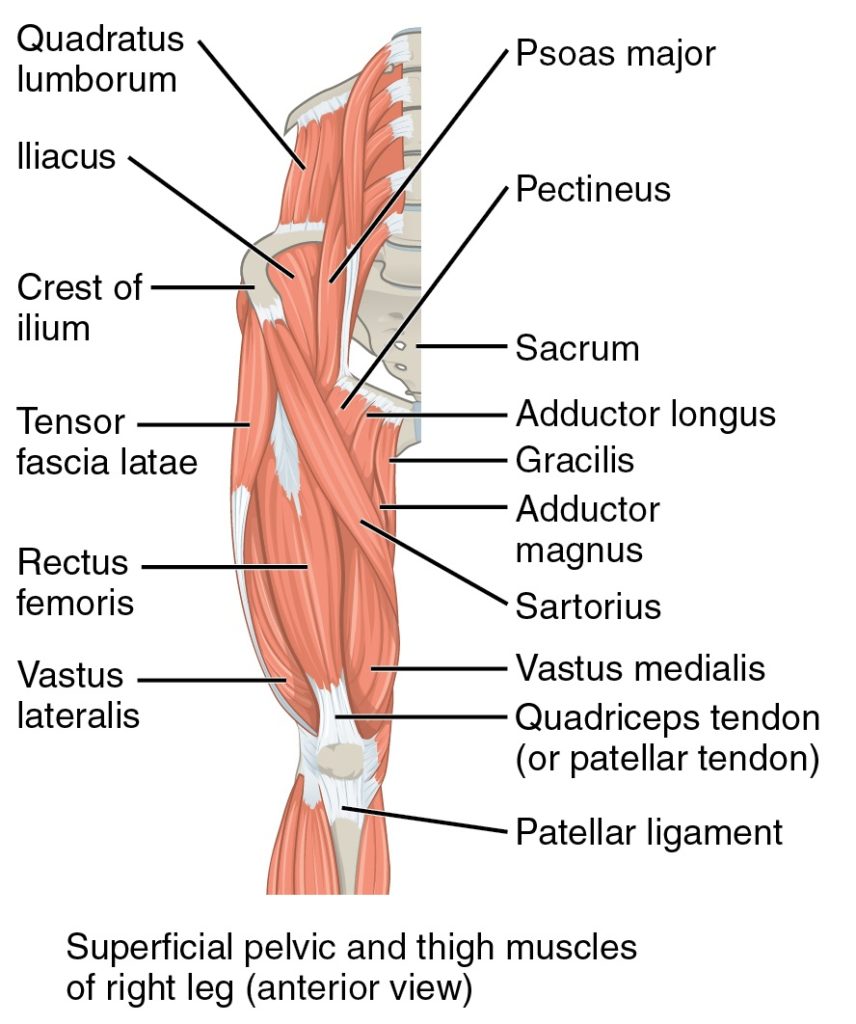



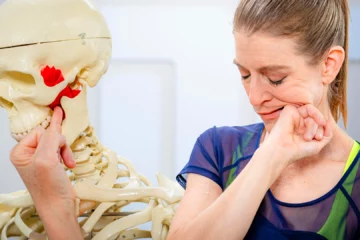
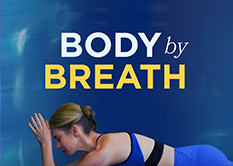



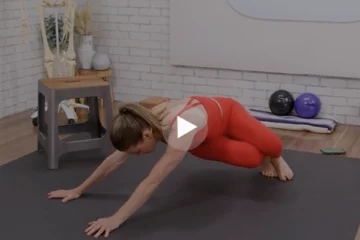
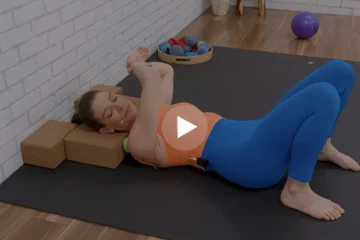


Adductor slides for the win! Hip pain and imbalance is just so common that it’s been almost established as something normal. I believe one of the biggest factors for our hip issues is the body blind spots that we all have and rarely address such as the adductors. Also, I think we don’t spend enough time on balance and stability training which is crucial for hip and pelvis health. Thank you for sharing your experience with us!
I LOVE the half happy baby flow! I had tightness and numbness in my lower legs and feet and it totally released after doing this flow!!!!
I appreciate the breakdown of this as the hips are so complex. It is wild how many people have issues with their hips, but even more so how many people deal with it chronically and just live with it. I really love the adductor slides particularly!
Hip pain was so normalized in my former profession as a dancer and many years ago it was so insightful to learn about hip anatomy and about how dancers so often live (or sit!) in the hips – we tend to think hip pain is inevitable for dancers but so much of it actually is preventable (even with the overuse of External rotation) if other skill work (internal rotation, parallel adductor/abductor work, PNfs etc), practices and awareness is used. YTUs educational piece is so refreshing because it enables people to stay with what they love – while balancing out the cost. I love the adductor slides and parallel training – and what I especially love about YTU is the embodiment itself. It was learning to sense my hips that I understood my hip pain was coming from anterior translation of the femur (basically jamming the front of the joint/impingement) and recentering that joint has given me healthy hips back AND like a PNF, it’s an adjustment I’ve learned to bring onto my mat anytime my hips need a little support. YTU nurtures this awareness in so many wonderful ways – nothing better than a YTU hip flexor rollout followed by parallel inner and outer hip activation!
Agree! I also realized the asymmetry of the strength in my hip directions of movement was the cause of my hip pain. Focusing more on adductor and internal rotator health (strengthening, as well as self myofascial release with the YTU balls) was the key for me.
YES! The obsession with equating “hip opening” with just pigeon pose (and its other external rotation friends) makes no sense at all when you look at all the different directions of movement possible in the hip joints! As a person with already-flexible hips, adding more diverse hip strength work to my practice was the missing piece for me to be more pain-free.
Thank you for this informative article. You’re so right that we tend to do the same exercises repeatedly and expect positive results. Thank you for explaining the multiple ranges our hips need to be involved with.
Working your inner and outer thighs is key to overall strength and stability especially in your pelvis. We live in a very quad and hamstring dominate world. Your video was great!
Vinyasa yoga can be great, for many reasons, but too much of a good thing is still too much. Joint health and stability trumps getting as low as you can go in Warrior II!
Thank you for this article! It is true that we neglect our adductors. I see a lot of people just bet on the leg stretches and forget to strengthen them!
Thanks Lauren ! 🙂
‘I learned how much harm I was doing by focusing on too much of one thing’
A couple of years ago I realized this very same thing.
I got the same problem with my left hips and the exercies of Yoga Tune up was very helpful.Thank you!!
It is very important to reduce repetition on the same hip in vinyasa yoga and your experience show it very well. Thank you for sharing.
Thank you for sharing this. It made me really realize and understand that, in order to stretch, you need to be strong.
Lauren, thanks for your post with video exercises included. I can definitely relate to your sentiment on overactive external rotators of the hip. As a previous performer in contortion and aerial arts, I’ve overused these same muscles typical in yoga practice. I actually starting my movement training in yoga before my performance days in the circus.
My favorite exercise, and I have to admit my least favorite, are the adductor slides. When I do them I keep my hip health so amazing that my snapping hip syndrome goes away almost within the day! These adductor slides are truly important, I would think for most of the general population too. So many of us have weak inner thighs and more external rotation in our hips. The first exercise you posted really helps to create more balance in the body.
The last video, Jill’s Half Happy Baby, is truthfully my happy place. It’s one of my favorite positions to take repose with some active flexibility triggered as I zone out into day dreaming. Doing the adductor slides beforehand really help to smoothly transition the hips into the further demands Half Happy Baby requires to do successfully and with more pleasantry of experience.
I had bilateral hip replacement 7 years ago and I know that now maintaining internal rotation and adduction is so important. It has taken me years to rehab and strength has been of the utmost importance.
Thanks for sharing.
I’m having similar experience about my hips. When i first started yoga, I had no knowledge of anatomy. I thought that the deep I stretch, the more it will open up my hips for lotus. Sometime last year, I start to find these sudden sharp pains in my hips, sometime the pain was so painful I couldn’t move at all. The exercises from physical therapist helped a little bit, but I find the the pain keeps coming back. At the YTU training with Jill this week, I learned and realized I have over stretched my hips.
The idea of increasing variety of loads to stabilize our joints is vital and I’m seeing this in my body significantly as a dancer having spent most of my life in external hip rotation
I totally agree, Yogis focus too much on external rotation, like a ballet dancer…. Hip replacement?
I’ve had the same pain as you were describing as well. I also found relief doing the YTU Moon Rises to strengthen the internal/external rotation and the Jithara Parivartonasana Variation 4 to get deeper into the core/hip connection.
Thanks for your article.
This article comes to me at the perfect time, because it just brought a hip injury on the right side, I am already improving but I still have contracted muscles, external hip rotators but especially the adductors. My injury was such that I could not rotate externally, separate and bring my leg closer to the center. And it was precisely with The Roll Model® balls that I had a great improvement in pain reduction and range of motion. I have also done some Yoga Tune Up® postures such as Prasarita Desplants and Abducot Lifting (with limited range), but the one mentioned in the article Adductors Sliding has cost me a job; I have not tried the Half of Happy Baby Minivini position but I think it will be of great help. In this case I did not really know how I got hurt, but I agree with Lauren that many times we focus on working some muscle and overload it until we get hurt, and we still practice like this and compensate with other muscles and we go backwards because we continue to hurt our body, instead of improving our practice and doing it more consciously.
Totally agree with your assessment. Moving the joint through full range of motion, building strength and mobility is the key. However, what to do if this does not alleviate the pain?? I found certain aches and pains improved after strength training within a few months.
Along with Jill’s experience I feel like there has been a lot of coverage about hip issues for yogies. Strength of the adductors tend to be overlooked but are needed for a well balanced hip. The adductor slide is one of my favorite YTU moves for this underworked area.
This is a great reminder to look at the big picture when addressing pain in the body. The body needs to work as a whole, in order for the parts to be healthy.
The title of this blog immediately captured my attention because I have very tight hips and often don’t know how to go about working on them. It makes so much sense that in order to have a stable hip I would need to strengthen my adductors and inner thigh. I didn’t realize how much in Yoga we overstretch some of these muscles instead of strengthening them. I loved when you said that it created an imbalance in your body because I feel the same way. Also, I tried both (the adductor slides and half happy baby mini vini) today and felt so different in my hips but in a good way. At first, I was nervous about the mini vini sequence but after doing it a few times and moving my hip around its joint, I enjoyed it. I can’t wait to use this in one of my classes instead of going straight into cuing the full version of Happy Baby.
It is magical to note that with a little movement in the correct alignment, it makes all the difference and allows a better flexion, a better mobility and brings reinforcement!
Thanks again for all your articles and video
It’s important for us to learn how to move our bady in different directions and most important is to learn to activate as much muscles us possible, when we excersise usually we only work or over work some muscles and forget about others. This is a good reminder of the importance to keep balance. Thank you.
Hips are really important for the well being and good balance of the posture. Its important to know strengths and weaknesses of our hips. Yoga and YTU help a lot and helped me a lot to understand my body to avoid injuries.
Yoga Tune Up teachings will make me understand the importance of mobilizing our joints in all directions and as often as possible to avoid injury.
We overuse the same joints day in and out in our lives and this article shows the reasons why all directions of movement are important to have lives with happy hips and abductors.
Blessings
Melaina Landriault
This is a good reminder to myself to diversify movements in every class that I teach. I only recently realized how much external rotation is involved in a typical Vinyasa class. Thank you for sharing your exercises!
Thanks for sharing , I have had pain and soreness in my right hip joint for a long time. But three weeks ago I did Hips immersion work shop that the first day we did the movements was the best that ever happened for my hips. We did abductor slides, monk walks,abduction and addiction of the hips and my hips opened up and now # happy hips. Learning and moving our bodies the right way helps us live better.
I am taking the YTU certification training, and it has helped me find my blidspots and weaknesses. Now knowing the different directions of movement of the hip, I can better balance my Pilates practice.
Thank you for sharing part of your movement journey. I’ve had similar experiences, not with pain in my hips, but in other areas of my body. And while I’ve had teachers pretty much from the beginning, focus on tissue strength, everything started to make more sense in my body a bit before and a ton after I finished the YTU certification training. Such a wake up call to blind spots in my previous practices!
This is great! I never thought of it this way, but there is definitely a lot of external hip rotation in yoga. Not to mention a million pigeon poses that just re-enforce the same pattern! Very helpful article to consider varying movements, especially for our students.
Love this blog! I have this same issue! I am adding adductor slides and Happy Baby Mini Vini’s to my yoga practice.
Thank you
Great example of the uniqueness of our bodies. I appreciate how Lauren doesn’t forsake Vinyasa but instead contextualizes how the needs of her body were not being addressed by that particular practice. It reinforces the concept that cues are based on context. It also shifts the responsibility of taking care of your body from the teacher to the individual. When we take responsibility for our actions and our choices, we have no one else to blame but ourselves, both for the good and the bad. Scary but also empowering!
This is my area of concern and I got there doing exactly what the author did. Now I am in rehab and my number 1 go-to is Adductor Slides. Yoga world out there – stop with the crazy hip openers!
Another exercise that we can add to the list for strengthening these neglected adductors is to squeeze and release a Coregeous ball between the thighs.
I came to the same realization when I started my Yoga Tune Up Teacher training. Initially I felt yoga was stretching and strengthening my entire body evenly. I have also experienced the same hip tightness. Adductor Slides and 1/2 Happy Baby Mini Vini are now part of my practice! Thank you!
Good info. I think we all experience hip issues at some point. Good video.
Dynamic stretching and PNF. The results are impressive. Thanks for this article.
Hello Lauren and thank you for your post! It is really not easy to put all connections and interactions together in our body, but you’re very simply emphasizing on why and how to be aware of hip /leg adductors was really helpful for me!!!
I went to see a therapist for my right hip. The person put her fingers or whatever in the hip joint and have a hurting body today
Any help
I used to suffer from frequent hip pain due to overuse and overstretching in yoga so I related quite a bit to this article. I personally found my way out of the pain was to strengthen my glutes and hamstrings. Good old fashioned clamshells with a resistance band and working out with a kettle bell has worked wonders. I also started incorporating more hamstring strengtheners into my yoga practice — purvotonasana has become one of my favorite poses after years of avoiding it!
Somehow, strenghtening the inner thigh muscles is not something I am naturally interested in doing in my regular yoga practice. Lately, I’ve developed a sensitivity in my right knee when putting pressure on it (kneeling on the floor). I wonder if working on building inner thigh resilience could potentially help…I’m willing to give it a shot!
I had similar experience. In addition to my back issue, years of vinyasa practice enhanced the imbalance in my hip joint and muscles around it. Thanks for the article. It seems this is exactly what i need now.
My past includes numerous joint surgeries, both elbows, both knees, and abdominal surgery that included a partial hysterectomy with meshing to support my bladder and vagina. After working with a pelvic floor physiotherapist I understood how important it is to maintain overall supple strength. Attending YTU/Roll Model classes for the past 4 years and committing to daily rolling and poses, I am pain free. Three cheers for YTU Adductor slides and Half Happy Baby Mini Vini.!!
Love how this points out and address a Yoga blind spot, especially for those of us who teach or practice a Vinyasa flow style of practice. I am so grateful to be aware and to understand these blind spots and am looking forward to seeing how my own practice and my students practice will begin to transform with a more balanced and conscious approach to practicing and sequencing. Thank you Lauren and YTU!
Excellent blog! Finding the cause to pain is so critical to treating it and prevent further injury. Good job! The hip is complicated because it moves in so many directions with many muscles involved, but you did it and feel better!
Absolutely agreed on overstretching the muscle, especially when we talk about hips. I was blaming my hips for not being “open” enough when i injured my knee. We always emphasize on external rotation and abduction practicing asanas such as Vrikshasana (tree) or all the variations of triangles, side angles etc. But we forget to strengthen the muscle before lengthen it. And then we find that our adductors are weak. By performing Adductor Slides you strengthen the adductor group( add. magnus,longus,brevis, pectineus,gracilis) which gives so much support for the knee and helps to stabilize the joint. It’s definitely not the easiest exercise but my and knees love it and i finally feel what is it like to “activate your inner thighs”.
Thanks so much for this. I’ve been aware that the constant external rotation is becoming a hot topic in the cutting edge / functional movement minded yoga community – but the combo of the write up / illustration and video helped it finally gel. I kept thinking if I cued “draw the thigh bones towards each other like scissors” in poses like warrior 2 that I could counter some of this over stretching – but this brings the exploration of the full ROM into light.
Half happy baby definitely gets me into recesses of my hip that I have not been able to get to in pidgeon or figure four. This movement allows for opening of external and internal rotation as well as centration in the hip joint as well as decentration which the hip needs to do both in order to stay healthy and not overly compress when walking or sitting.
A couple of years ago I started having knee pain because of weak adductors as well. It was so empowering to be able to relieve the pain myself with some attention to movement.
So true Lauren, there are these areas in the body which are overstretched and utilized in the same way in yoga. YTU is such an amazing practice to start to correct this imbalance. Thank you for sharing your insight on this.
Hi Lauren, great article thanks for sharing your experience. I’ve also been through this same cycle of discovery with my left hip. I’m still working on strengthening the glute medius and the TFL (where I’m weakest) and keeping it all mobile. I’m trying to forget about the lack of flexibility for now but sometimes ego gets in the way! Lorraine
I definitely need to work on my internal rotators too. That Half Happy Baby Mini Vini is a game changer for sure. Being able to get your hips flowing through that many directions of movement so efficiently is crazy.
Yes, unfortunately something as healing as yoga can sometimes be another source overuse for some parts of the body. A great hint as to why we should change up our practice/sequence and even “style” of practice often.
I’ve recently came to this realization that the joints and the muscles move together. I used to think of poses in isolated, myopic view. For a lot of people, adductor muscles are very weak from underutilizing them. However, they’re a part of a lot of physical activities that we do.
As a former dancer I have experienced the foibles of extreme external rotation for prolonged periods of time and came to yoga with some skepticism – not about the practice of the poses but rather on my body’s ability to facilitate the movement properly.
I was pleased that through steady practice over time, I was able to achieve more mobility and strength. However, I still feel there is more to go, of course.
Adductor slides are a fantastic exercise for me as try identify my inherent weakness but also provide me with a way to condition the default that I have.
Half happy baby also allows me to explore range of motion that I didn’t think was possible my post dance hip joint as it is done in a safe and supportive way.
I love the way Jill speaks about blind spots in the body. It helps to absolve me of guilt and frustration when certain yoga poses seem out of reach. Her exercises and movement philosophy is like a light at the end of a tunnel.
At some point my body started refusing all the hip external rotating yoga poses such as Warrior2 , horsestand, straddle…etc And only wanted to do the adducting! I also have hip pain (not sciatica but more in my glute mid & around sijoint) – But haven’t yet figured out how deal with it yet! You article motivates me to start doing the strength trainings!
I am absolutely guilty of spending too much time focusing on external rotation of the hips. I spend very little time on internal rotation. Thank you for the reminder. I am going to try your recommended exercises this evening!
I am completely of guilty of focusing too much on one thing and especially the external rotation of my hips. I never even considered internal rotation to relieve pain. Thank you for the at home exercises! Internal rotation!
Thank you for your concise article and for including the videos of the exercises. As practitioners, it is so important that we understand that “overstretching” might increase flexibility but also cause more problems such as degenerating tissues. So thankful for Yoga Tune Up and blog contributors like YOU!
I love adductor slides they have been really helping me balance my hip strength as well.
I am also guilty of focusing too much on one thing. I have spent much of life in external rotation from ballet and now yoga, and have noticed an increase in hip pain. This article is great reminder to incorporate more internally rotated poses (or at least movement in all directions) into my practice and teaching and strengthening as well.
I have been looking for ways to target the adductors. These exercises provide a great way to strengthen these muscles, and increase flexibility and mobility.
great write up and explanation of the need to build stability around flexibility and overstretch; as a hyper mobile person building strength around the hip joints has changed my practice from being in my joints to being in my muscles with mobility
Thank you for the reminder to work those adductors. Did some frog crawls today on the blanket and the adductors are still talking about it. 🙂
Unfortunately many yoga classes overuse external rotation. As a long-time yoga student and teacher, I especially see the effects of this practice. This article is great — lots of information delivered succinctly.
Very useful post truly. Nature had a great way of finding ways to get to balance. Best to help her along rather than to fight her (:^)
Thanks for the post! As a yoga teacher and massage therapist I have a lot of clients who complain about their hips being tight and want to focus on stretching and loosening the lateral rotators and glutes without considering the antagonists. This looks like a great, accessible way for people to strengthen weak adductors!
Thanks for the post! As a yoga teacher and a massage therapist, I have lots of clients who complain their hips are tight and want to focus on stretching and opening up the lateral rotators without considering the antagonists. This looks like a great, accessible way to address weakness in the adductor group! Can’t wait to try it!
As I read this article on day 4 of YTU Level one it makes way more sense to understand how to truly open my hips! I need to have everything going on: internal and external rotation, flexion, extension and circumduction – wOW- I need to restructure my yoga practice
I am so grateful to have found the yoga tune up for my imbances and learning how to correctly strengthen , lengthened and mobilize! After working my hips with the Yoga tune up method my hips had never felt happier.
This blog post resonated deeply with me. As a 25 year old I struggle with hip pain and have for almost 10 years. I had some more juvenile “Athletic Therapists” make quick assumptions and conclusions that I had a leg length discrepancy, which they decided I needed to treat with a heel lift in my shoe. I wore this heel life for over two months. I then went away to University in Virginia and the medical team and doctors at the school were incredible. The first thing they had me doing was strengthening my core and my glutes. At first I was irritated and impatient. It took me some time and I am still learning more and more about what a better initial approach would have been (physio to strengthen certain things) before throwing a heel lift in my shoe! Learning to deconstruct an injury and using anatomy to understand what the root of the injury could be by knowing what is connected is something I feel will be so beneficial for the athletes that I coach.
Lauren, I find your article very interesting as I have been doing a lot of lateral hip flexion in my yoga practice and have noticed left hip pain increasing even when I’m not moving. I will try your adductor slides suggestions and see if it helps my condition
Hi, I heard your story on J.Brown podcast and identified so much with your experience. However, now I afraid to do Yoga. Not sure if I’ve been hurting myself all this time. I have hip pain, etc. I also teach yoga a bit. Are you saying that traditional Triangle, side Angle, etc are harmful. I’m so confused. Where do I go from here????
Hi, in addition to the two videos, you write that you also strengthen “inner quadriceps, gluteals, hamstrings, adductors, and psoas”. Could you also provide links to videos that will show how to do that? I had terrible pain in my legs that is now better by making the hips a lot more flexible but I now have terrible hip pain and can’t sleep on my side. I have a feeling I am in a similar situation and need the right exercises… many thanks!
In the yoga world, we always want to “open my hips” or “open my heart”. How to define OPEN hips? Does that mean how width my leg split look like or how well I can do the locust pose? A lot of time, until I overuse/ underuse a part of the body and “pain” as a symptom to tell me I did something wrong. Thanks yoga turn up provide me new tools to study my body.
Thank you for the article Laueren. Uderstanding the importance of mobility at the hip joints was one of the milestones of my practice and teaching. Externally rotated yoga poses are too deep for most of the students and when they try to get into the pose without hip mobility it easily cause injuries or sacrificing somebody parts from the alignment. Happy baby mini vini( also with strap) is suitable for most of the body types to gain hip mobility.
Outstanding, Lauren! Thanks for pointing out the pitfalls of excessive external rotationfor Yoginis and dancers alike, and what we can t strengthen our inner thighs and adductor muscle groups.
This is great info as a yogini. My practice is Ashtanga Mysore and many poses require extreme external rotation. I like this healthy overall approach to the hips to continue to practice with intelligence over time.
Thanks for sharing the videos! It is a great reminder to avoid overdoing any single stretch or action to the point of creating imbalance.
Hello,
This is so interesting.
When I was consistently riding horses, I had no hip pain from yoga.
I realize this was likely because you are constantly adducting your hips and inner thighs while riding which is a perfect antagonist for external rotation of the hip –giving the support the hip needs while rotated.
Thank you for your tip and I will continue to do Jill’s minivini as well.
Namaste,
Paige
Great post! I had no idea how little I worked my adductors until I tried warrior 2 with the back foot on a blanket. Scratch and eye opening. Thanks for all the helpful exercises!
Hi Lauren,
thanks for sharing this blog post. I´m struggeling for quite some time with the focus on streching bodyparts without strengthen them to support the stability. It´s also quite usefull, that you´ve listed some asanas that are basing on the same direction of movement (external rotation). I´ve never thought of that and it will help me to rethink my personal practice and the development for my students practices.
Having experienced hip pain myself I found this extremely helpful! Thanks!
I understand this completely. I have had the same issues over the years and really need to strengthen all the muscles around my hips.
Lauren, I can totally relate to your hip issue. As a trained ballet dancer we are in external rotation much of our practice. Once I started focusing on balancing my body with strengthening of the adductors and internal rotators in my fitness training, using the Yoga tune up methods, my hip is so much happier.